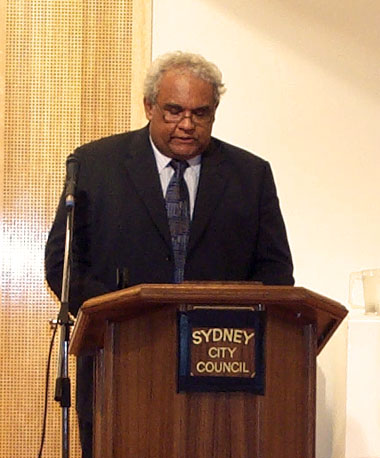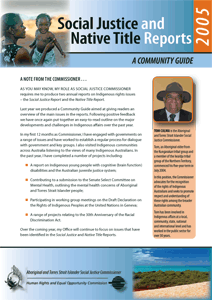Community Guide to the Social Justice and Native Title Reports 2005
Community Guide to the Social Justice and Native Title Reports 2005
- A note from the Commissioner
- The Indigenous Health Challenge
- Equality within a generation
- The Indigenous land tenure debate
- 12 months on ... the new arrangements for Indigenous affairs
- Fact Sheets
- Key terms
- Download the Community Guide in PDF

A note from the Commissioner
As you may know, my role as Social Justice Commissioner requires me to produce two annual reports on Indigenous rights issues - the Social Justice Report and the Native Title Report.
Last year we produced a Community Guide aimed at giving readers an overview of the main issues in the reports. Following positive feedback we have once again put together an easy-to-read outline on the major developments and challenges in Indigenous affairs over the past year.
In my first 12 months as Commissioner, I have engaged with governments on a range of issues and have worked to establish a regular process for dialogue
with government and key groups. I also visited Indigenous communities across Australia listening to the views of many Indigenous Australians. In
the past year, I have completed a number of projects including:
- A report on Indigenous young people with cognitive (brain function)
disabilities and the Australian juvenile justice system;
- Contributing to a submission to the Senate Select Committee on
Mental Health, outlining the mental health concerns of Aboriginal
and Torres Strait Islander people; - Participating in working group meetings on the Draft Declaration on
the Rights of Indigenous Peoples at the United Nations in Geneva; - A range of projects relating to the 30th Anniversary of the Racial
Discrimination Act.
Over the coming year, my Office will continue to focus on issues that have
been identified in the Social Justice and Native Title Reports.
 Tom Calma is the Aboriginal and Torres Strait Islander Social Justice Commissioner.
Tom Calma is the Aboriginal and Torres Strait Islander Social Justice Commissioner.
Tom, an Aboriginal elder from the Kungarakan tribal group and a member of the Iwaidja tribal group of the Northern Territory, commenced his five-year term in
July 2004.
In this position, the Commissioner advocates for the recognition of the rights of Indigenous Australians and seeks to promote respect and understanding of these rights among the broader Australian community.
Tom has been involved in Indigenous affairs at a local, community, state, national and international level and has worked in the public sector for over 30 years.

'Angelina and Baby'
Bathurst Island 2004 © Heide Smith
The Indigenous Health Challenge
"I am recommending that the governments of Australia commit to achieving equality of health status and life expectation between Aboriginal and Torres Strait Islander peoples and non-Indigenous people
within 25 years."
Tom Calma, Social Justice Commissioner, 2005
IMPROVING THE HEALTH STATUS OF ABORIGINAL and Torres Strait Islander peoples is a longstanding challenge for governments in Australia. While there have been some improvements since the 1970"s, overall progress has been slow and inconsistent. The inequality gap between Aboriginal and Torres Strait Islander peoples and other Australians remains wide and has not been significantly reduced.
Aboriginal and Torres Strait Islander peoples do not have an equal opportunity to be as healthy as non-Indigenous Australians. Aboriginal and Torres Strait Islander peoples do not enjoy equal access to primary health care and health infrastructure which includes safe drinking water, effective sewerage systems, rubbish collection services and healthy housing.
Governments have made commitments to try and address Indigenous health inequality but always without a specified time frame.
Incremental funding increases have not been enough to match Indigenous health needs and, although there have been a number of well intentioned strategies and frameworks in Australia, there are few improvements to the health of Indigenous Australians.
The data remains bleak and shows only slow improvements in some areas of health status with no progress on others over the past decade. However, significant work has been completed over the past 3 years to reinvigorate the commitments of governments to address Aboriginal and Torres Strait Islander health inequality through the National Strategic Framework for Aboriginal and Torres Strait Islander
Health.
This National Strategic Framework sets the foundation for future work in the area of Indigenous health inequality. The need to address Indigenous health from a holistic perspective is identified as an essential
commitment governments should make. Such an approach means that governments must commit to working in a holistic manner at a program and policy level, to take a whole of government approach, and most importantly, to do this in partnership with Aboriginal and Torres Strait Islander peoples.
The Social Justice Report 2005 proposes a human rights based campaign to address the health inequality of Indigenous Australians and asks governments to commit to addressing the health status of Aboriginal and Torres Strait Islander peoples within a set timeframe. The human rights based approach advocates that Aboriginal and Torres Strait Islander peoples have a right to health.
. . . equality within a generation
|
The right to health has 4 essential elements:
|
It is a realistic aim for governments to commit to ensuring an equitable distribution of primary health care and equitable standards of health infrastructure (such as water, sanitation, food and
housing) in a time period of no more than 10 years.
-
Further, it is realistic for governments to commit to the goal of achieving equality of health status and life expectation within the next generation.
This would be in approximately 25 years. Governments must commit to increased funding levels that match the needs of Aboriginal and
Torres Strait Islander communities.The main emphasis in rolling out the human rights based approach is for governments to build on already existing structures such as the National Strategic Framework
and to incorporate a number of monitoring mechanisms to make sure that governments are accountable. It is recommended that the goals and aims of the National Strategic Framework
for Aboriginal and Torres Strait Islander Health be incorporated into the operation of the new arrangements for Indigenous affairs and in particular the Indigenous Coordination Centres.This means that the whole of government structures that have been developed through the new arrangements for Indigenous affairs will be utilised and further built upon.
The Social Justice Report 2005 proposes that the Australian Health Minister’s Conference agree to a National Commitment to achieve Aboriginal and Torres Strait Islander Health Equality and that bipartisan
support for this commitment be sought in federal Parliament and in all state and territory parliaments.This would mean that all governments commit to a program of action to address this inequality and aim to achieve equality of opportunity in the provision of health care and health infrastructure
in 10 years.Governments should also commit to continue to work to achieve improved access to mainstream services as well as continued support for community controlled health services with the
full participation of Aboriginal and Torres Strait Islander peoples.The National Commitment by governments should acknowledge that achieving such equality for Aboriginal and Torres Strait Islander peoples will contribute significantly to the
reconciliation process.
Bathurst Island, 2004.
Copyright © Heide Smith.The Indigenous land tenure debate
The Native Title Report 2005 focuses on the Australian Government"s proposal to encourage private ownership and private leases on Indigenous lands.
In 2005, the Prime Minister announced that he wanted to make "native title and communal land work better" by adding "opportunities for families and communities to build economic independence and wealth through use of their communal land assets."
The National Indigenous Council"s Indigenous Land Tenure Principles were published soon after the Prime Minister"s statement. These principles are directly aligned with the Prime Minister"s statement. The National Indigenous Council principles are designed to secure "improved social and economic outcomes from [the Indigenous] land base, now and into the future, but in a way that maintains Indigenous communal ownership."
While the intention to build economic independence on Indigenous land is welcomed and desirable, the Native Title Report 2005 argues that there are concerns about the content of the Indigenous Land Tenure Principles.
The Native Title Report 2005 argues that individual lease options will not improve economic and social outcomes on Indigenous land. While land that is Indigenous-owned, controlled or set aside for the use of Indigenous peoples comprises approximately 16 percent of the area of Australia, the bulk of it is very remotely located and lacking the most basic infrastructure. This is one of the primary impediments to economic development.
Furthermore, under existing arrangements, it is currently possible for Indigenous people to take out individual leases in every state and territory. Despite this existing opportunity, economic development has not flourished to date. Individual leasing of communally owned land is not, in itself, the solution to improve social and economic outcomes for Indigenous peoples.
The Native Title Report 2005 argues that in their current form, the Indigenous Land Tenure Principles do not consider the various factors that impede opportunities for economic development on Indigenous
land. They include:- native title law allows very few rights to land development and land assets. In most cases, native title provides traditional owners with little more than access to
land; - much of the land under native title and land rights is marginal, arid desert or geographically isolated, and there is limited potential for economic development;
- much of the land under native title or land rights lacks the most basic infrastructure to support development projects;
- the entities with responsibility to progress native title interests to land,1 have either no funding, or insecure funding;
- many Indigenous people in remote communities lack access to employment, and the means by which to repay mortgages or other debts to land; and
- to date, there has been a lack of government policy to support economic development initiatives on Indigenous land.
In order to promote economic development and to support housing development, governments must increase resources for both infrastructure and enterprise development projects.
Government policy and commitment is required to support and sustain these activities over time. Maintaining traditional owner governance over land is essential in the development of these projects.International experience tells us that carving Indigenous land into small private land parcels creates more problems than it solves. Other countries, including NZ and USA, have attempted to remove communal land rights, and they are now reversing these policies. Australia should not make the mistakes that have been made elsewhere.
In addition to presenting arguments about land tenure, the Native Title Report 2005 outlines human rights concerns with the Indigenous Land Tenure Principles, Principle 4 proposes that in order to facilitate the
process of granting individual leases:
the consent of traditional owners should not
be unreasonably withheld for requests for
individual leasehold interests for contemporary
purposes;involuntary measures should not be used
except as a last resort and, in the event of any
compulsory acquisition, strictly on the existing
basis of just terms compensation2
This principle is at odds with the very purpose of land rights and native title rights. The Native Title Report 2005 argues that Principle 4 is not consistent with Australia"s obligations to protect the rights of its Indigenous citizens, and if implemented, would breach the Racial Discrimination Act 1975.For traditional owners, the proposed Indigenous Land Tenure Principles may represent a foreign and Western view of wealth creation, which may be at odds with traditional views of communal ownership and communal tenure. Therefore, the Native Title Report 2005 advocates the requirement for parties to obtain the free, prior and informed consent of traditional land owners before any amendments are made to legislation or policy affecting Indigenous interests to land.
See the NIC principles online at: www.atsia.gov.au/NIC/communique/PDFs/LandTenure.pdf
See the Native Title Report 2005 online at https://humanrights.gov.au/our-work/aboriginal-and-torres-strait-islander-social-justice
or for a hard copy contact 1300 369 711.
This ocean image is taken near Broome, Western Australia. In the foreground is a midden
(a sandbank covered with shells discarded by the local people after the contents were
eaten). Below the midden are the mangroves where all types of seafood is hunted and
collected and finally, the beautiful warm waters. © Wayne Quilliam.
1 Prescribed Bodies Corporate
2 National Indigenous Council, Indigenous Land Tenure Principles,
2005, emphasis added, <http://www.atsia.gov.au/NIC/communique/PDFs/LandTenure.pdf>
This fire image was taken in the Kimberleys in Western Australia, as with many
Aboriginal groups throughout Australia fire is used to regenerate the land, the natural
process has been used for tens of thousands of years to sustain the earth.
© Wayne Quilliam.12 months on ... the new arrangements for Indigenous affairs
In last year's Social Justice Report I committed to monitoring how the new arrangements for Indigenous affairs impacts on Aboriginal and Torres Strait Islander peoples"enjoyment of their human rights.
A key human rights issue in the new arrangements is the quality of Indigenous peoples" participation.
Human rights law requires that when governments make decisions about issues such as: Indigenous peoples" socio-economic development; self-determination; right to non-discrimination or their right to different and appropriate treatment as minority cultural groups, that Indigenous peoples are able to participate in the decision-making process. Effective participation ensures that decisions are not imposed on people and communities.
The Social Justice Report 2005 identifies four elements to ensuring effective participation:
- INDIGENOUS REPRESENTATION AT ALL LEVELS OF DECISION MAKING
Gaps still remain in Indigenous representation at local, regional and national levels.
Regional representative bodies should be established as soon as possible, particularly through Regional Partnership Agreements (RPAs). - PROCESSES FOR GOVERNMENT ENGAGEMENT WITH INDIGENOUS PEOPLES
The new arrangements promise improvements to the way governments engage with Indigenous peoples and communities.
The creation of regional Indigenous Coordination Centres (ICCs), or government "one stop shops", are one way this may be achieved, however, 12 months on it is still too early to assess their success. - MECHANISMS FOR ENSURING ACCOUNTABILITY AND TRANSPARENCY
The new arrangements aim to improve the lives of Indigenous peoples - their health, education, communities etc.
But without the existence of better monitoring and evaluation processes it is difficult to tell whether the new arrangements are improving things or not. - INDIGENOUS PARTICIPATION THROUGH AGREEMENT MAKING AND PLANNING PROCESSES
Shared Responsibility Agreements (SRAs), highlight the need for the effective participation of Indigenous peoples, are discussed in detail below.
Shared Responsibility AgreementsIn examining whether a SRA is in breach of human rights, it is important to look at each agreement individually and not make generalisations. Factors to take into account include whether a SRA
was negotiated according to the principle of free, prior and informed consent. There is also the question of what is being provided through a SRA.A SRA that provides business opportunities, community facilities or training places is likely to conform to human rights obligations.
A SRA that makes the provision of health services, food, water and sanitation dependent on the community providing something in return could be in breach of human rights principles.
For further information on the articles in this Community Guide see the following fact sheets available on the Human Rights and Equal Opportunity Commission"s website at https://humanrights.gov.au/our-work/aboriginal-and-torres-strait-islander-social-justice
Fact Sheet One: Reforms to the Community Development Employment Program
Fact Sheet Two: Shared Responsibility Agreements
INDIGENOUS HEALTH FACT SHEETS
The Indigenous Health Challenge: A national commitment to health equality
Health Fact Sheet One: The health status of Aboriginal and Torres Strait Islander peoples
Health Fact Sheet Two: The socio-economic status of Aboriginal and Torres Strait Islander peoples

Aboriginal and Torres Strait Islander Social Justice
Commissioner Tom Calma discussing a range of
Indigenous issues at a recent community forumKey terms
What are the new arrangements in Indigenous affairs?
After the abolition of the Aboriginal and Torres Strait Islander Commission (or ATSIC) the Australian Government put in place a series of reforms that are known as the "new arrangements for Indigenous affairs". Key elements of these are ICCs, SRAs and RPAs.
What are ICCs? (Indigenous Coordination Centres)
The Office of Indigenous Policy Coordination (OIPC) was established in Canberra and each capital city to coordinate policy nationally and ICCs have been set up in each of the former ATSIC regions to deliver a whole-of-government approach to programs and service delivery on a regional basis and to collaborate with Indigenous communities at the local level.
What are Shared Responsibility Agreements?
The term "Shared Responsibility Agreement" describes an agreement that is based on the principle of mutual obligation between Aboriginal and Torres Strait Islander communities and groups and Australian governments.
What is mutual obligation?
In practice, this means that governments agree to provide things to a community on the condition that the community agrees to provide something in return.
What are RPAs? (Regional Partnership Agreements)
RPAs will set out how governments and the community will engage at the regional level. Indigenous regional representative structures, when created, will play a key role in the development of RPAs.
What is free, prior and informed consent?
Free, prior and informed consent describes a process that should be followed by all people when they want to do business on Indigenous peoples" land or when they develop policies that impact on Indigenous peoples. The free, prior and informed consent process contains the following elements:
- Free - implies no coercion, intimidation or manipulation;
- Prior - implies that enough time has been allowed for meaningful community consultation and consensus building;
- Informed - implies that all the information necessary to make a decision has been provided and understood.
- Consent - means a community has the right to withhold consent to a proposal if they do not agree to it.
For further information refer to the Engaging the marginalised: partnerships between indigenous peoples, governments and civil societies brochure on the HREOC website at:
www.humanrights.gov.au/social_justice/conference/engaging_communities/index.htmlHandy Contacts For The Human Rights And Equal Opportunity Commission
Call 1300 369 711 to order hard copies and CD-ROMs of the Social Justice and Native Title Reports
and for additional copies of this Community GuideThe Social Justice Report 2005 is available at https://humanrights.gov.au/our-work/aboriginal-and-torres-strait-islander-social-justice
The Native Title Report 2005 is available at https://humanrights.gov.au/our-work/aboriginal-and-torres-strait-islander-social-justice
If you have any feedback please email us at sjreport@humanrights.gov.au
- native title law allows very few rights to land development and land assets. In most cases, native title provides traditional owners with little more than access to

